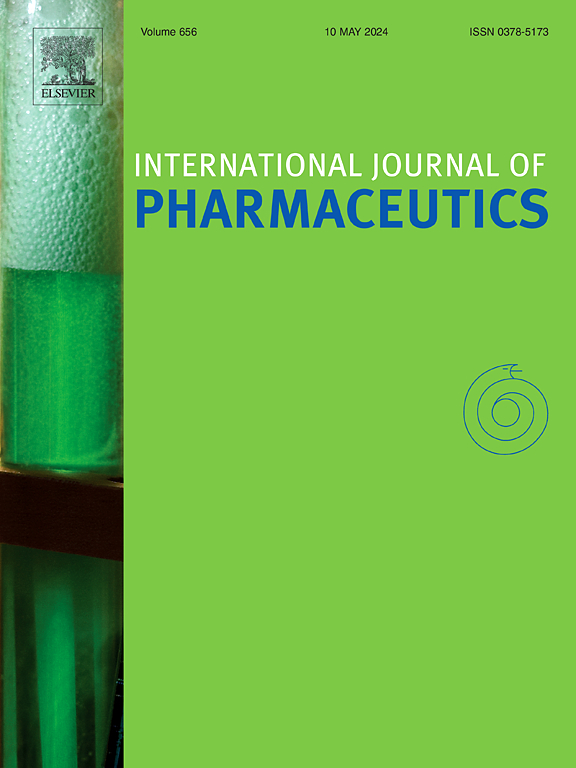Leveraging solid solubility and miscibility of etoricoxib in Soluplus® towards manufacturing of 3D printed etoricoxib tablets by additive manufacturing
IF 5.3
2区 医学
Q1 PHARMACOLOGY & PHARMACY
引用次数: 0
Abstract
This research focuses on exploring the solid solubility and miscibility of Etoricoxib, a poorly water-soluble anti-inflammatory drug, within Soluplus®, a polymer used as a matrix for 3D-printed tablets. By utilizing hot-melt extrusion (HME), the drug was dispersed within Soluplus® to enhance its solubility. The extrudates were then employed in 3D printing to create customized solid oral dosage form. This study’s novelty lies in combining HME and 3D printing, aiming to improve drug incorporation, stability, and effectiveness in the final formulation. Comprehensive characterization techniques, including hot stage microscopy (HSM), scanning electron microscopy (SEM), micro-computed tomography (Micro-CT), florescence microscopy, optical microscopy, X-ray diffraction (XRD), Fourier transform infrared spectroscopy (FT-IR), solubility studies, differential scanning calorimetry (DSC), thermogravimetric analysis (TGA), and aqueous solubility study were utilized to elucidate the physicochemical properties, thermal stability, and structural integrity for the extruded filaments (the printing ink), and 3D printed tablets made thereof. Furthermore, the in vitro drug release profile of the 3D printed tablet was systematically evaluated, revealing a controlled drug release pattern from the finished dosage form. The systematic investigation reported herein, starting from theoretical miscibility to the printing ink development through HME, detailed characterization of the extruded filaments, and further solid oral formulation development by additive manufacturing can be utilized as a platform technology or a pathway for the development of personalized medicine with drugs having similar physicochemical properties.

利用依托考昔在 Soluplus® 中的固溶性和混溶性,通过增材制造技术制造三维打印的依托考昔片剂。
这项研究的重点是探索水溶性较差的抗炎药物 Etoricoxib 在 Soluplus® (一种用作 3D 打印片剂基质的聚合物)中的固溶性和混溶性。通过热熔挤出(HME),药物被分散在 Soluplus® 中,以提高其溶解度。然后将挤出物用于三维打印,制成定制的固体口服剂型。这项研究的新颖之处在于将 HME 和 3D 打印技术相结合,旨在提高药物在最终制剂中的掺入度、稳定性和有效性。综合表征技术包括热台显微镜(HSM)、扫描电子显微镜(SEM)、显微计算机断层扫描(Micro-CT)、荧光显微镜、光学显微镜、X 射线衍射(XRD)、傅立叶变换红外光谱(FT-IR)、溶解度研究、利用差示扫描量热法(DSC)、热重分析法(TGA)和水溶性研究,阐明了挤出长丝(印刷油墨)及其制成的 3D 打印药片的理化性质、热稳定性和结构完整性。此外,还对 3D 打印片剂的体外药物释放曲线进行了系统评估,揭示了成品剂型的控释模式。本文所报告的系统性研究,从理论上的混溶性开始,到通过 HME 开发印刷油墨、详细表征挤压丝,以及通过增材制造进一步开发固体口服制剂,可作为一种平台技术或途径,用于开发具有类似理化性质的药物的个性化药物。
本文章由计算机程序翻译,如有差异,请以英文原文为准。
求助全文
约1分钟内获得全文
求助全文
来源期刊
CiteScore
10.70
自引率
8.60%
发文量
951
审稿时长
72 days
期刊介绍:
The International Journal of Pharmaceutics is the third most cited journal in the "Pharmacy & Pharmacology" category out of 366 journals, being the true home for pharmaceutical scientists concerned with the physical, chemical and biological properties of devices and delivery systems for drugs, vaccines and biologicals, including their design, manufacture and evaluation. This includes evaluation of the properties of drugs, excipients such as surfactants and polymers and novel materials. The journal has special sections on pharmaceutical nanotechnology and personalized medicines, and publishes research papers, reviews, commentaries and letters to the editor as well as special issues.

 求助内容:
求助内容: 应助结果提醒方式:
应助结果提醒方式:


